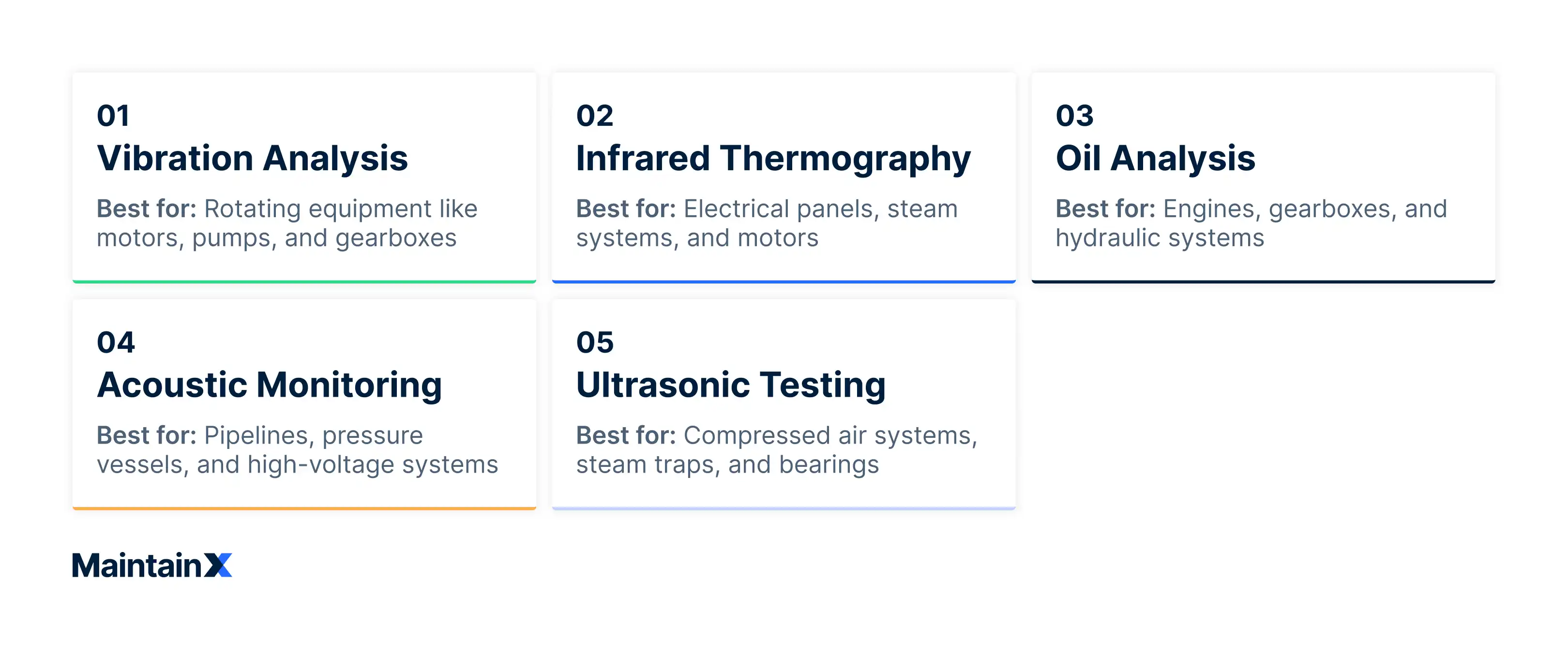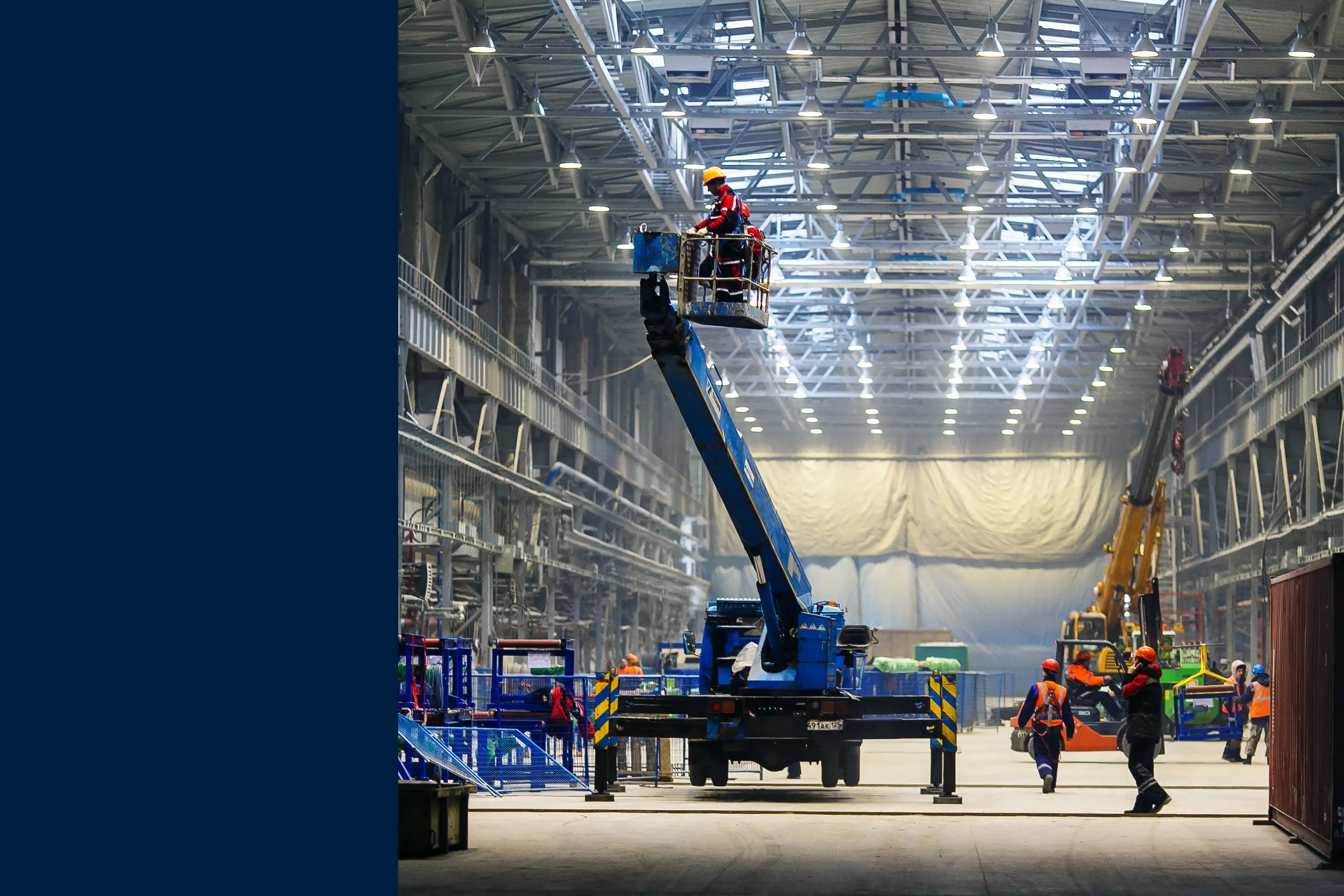
A predictive maintenance strategy transforms how maintenance teams prevent equipment failures. By monitoring equipment conditions in real-time, you can catch problems weeks or months before they cause downtime. But with multiple techniques available, which ones should you prioritize?
This guide covers the five most effective predictive maintenance techniques that MRO professionals use to keep operations running smoothly. You'll learn how each technique works, what problems it catches, and how to implement it in your facility.
Key takeaways
- Vibration analysis detects mechanical issues like bearing wear and misalignment in rotating equipment through frequency pattern analysis.
- Infrared thermography uses thermal cameras to spot overheating components, electrical problems, and insulation failures.
- Oil analysis reveals internal wear and contamination by testing lubricant samples.
- Acoustic monitoring identifies leaks, cracks, and electrical discharge by detecting ultrasonic frequencies beyond human hearing.
- Ultrasonic testing finds compressed air leaks, steam trap failures, and bearing problems through high-frequency sound detection.
What is predictive maintenance?
Predictive maintenance (PdM) uses real-time sensor data to determine when equipment needs service. Unlike preventive maintenance, which follows fixed schedules to determine servicing time, predictive maintenance monitors actual equipment condition through sensors and analysis tools to decide when to service equipment.
This approach helps you:
- Schedule maintenance only when needed.
- Catch problems before they cause failures.
- Reduce unnecessary maintenance tasks.
- Extend equipment life.
Unplanned downtime costs can reach as high as $150,000 per hour, even for small to medium-sized manufacturers, making PdM a worthwhile investment.
Benefits and ROI of predictive maintenance
The business case for predictive maintenance is compelling. According to a Siemens report on predictive maintenance ROI, organizations implementing these techniques see transformative results across their operations.
The most dramatic improvement comes in reliability. Companies report an 85% reduction in unplanned machine downtime by catching problems before they escalate into failures. This means fewer middle-of-the-night emergency calls and scrambles to find replacement parts.
Planning also becomes more precise. With a 50% improvement in downtime forecasting accuracy, maintenance teams can better coordinate with production schedules. Instead of guessing when equipment might fail, they know exactly when to schedule repairs during planned production gaps.
Your maintenance staff becomes more effective, too. Organizations see a 55% increase in maintenance staff productivity because technicians spend their time on meaningful preventive work rather than constantly fighting fires. They're fixing actual problems, not performing unnecessary maintenance "just in case."
Perhaps most importantly for the bottom line, facilities achieve a 40% reduction in maintenance costs. By eliminating unnecessary preventive tasks and preventing expensive emergency repairs, the savings add up quickly. With median unplanned downtime costs exceeding $100,000 per hour, preventing even one major failure can pay for an entire predictive maintenance program.
These improvements translate directly to the bottom line.
Check out this ROI Calculator and discover how MaintainX’s CMMS and EAM platform generates potential ROI in minutes.
Tools and technology behind predictive maintenance
Predictive maintenance is powered by smart tools that collect, analyze, and act on real-time equipment data. From wireless sensors to machine learning dashboards, here’s a look at the core technologies that make predictive maintenance possible.
Sensors and data sources
Modern predictive maintenance technologies rely on various sensors:
- Accelerometers for vibration
- Thermal cameras for temperature
- Ultrasonic detectors for sound
- Oil quality sensors for contamination
These sensors connect wirelessly to monitoring systems, which allows them to collect real-time data without disrupting your operations.
CMMS and integration platforms
A computerized maintenance management system (CMMS) serves as the central hub for predictive maintenance data. It aggregates sensor readings, triggers alerts when thresholds are exceeded, and automatically generates work orders for your team.
IoT and connectivity
Industrial IoT devices have made predictive maintenance more accessible than ever before. Traditional wired systems require extensive infrastructure and manual data collection. Meanwhile, modern wireless sensors eliminate this need for complex wiring, while cloud platforms mean you can monitor your data from anywhere in the world.
Data analytics and visualization tools
Modern software uses machine learning to identify patterns and predict failures. ML algorithms analyze thousands of hours of historical sensor data to learn what "normal" looks like for each piece of equipment. They identify subtle patterns that precede failures, such as combinations of vibration frequencies, temperature rises, or pressure changes that humans might miss.
When monitoring real-time data, these trained models can spot early warning signs and predict how long until failure occurs. Dashboards display equipment health scores, trending data, and maintenance recommendations in easy-to-understand formats.
Most common predictive maintenance techniques
Predictive maintenance works best when it’s tailored to the specific needs of your equipment and operations. Below are five proven techniques that help teams catch early warning signs and prevent costly failures before they happen.
1. Vibration analysis
Vibration analysis monitors the oscillation patterns of rotating machinery to detect mechanical problems. Every machine produces a unique vibration signature when healthy. As components wear, these signatures change in predictable ways.
How it works: Accelerometers mounted on equipment measure vibration frequency and amplitude. Software analyzes this data to identify specific problems:
- Imbalance (like uneven weight distribution) creates vibrations at the same frequency as the shaft rotation speed.
- Misalignment between coupled shafts produces vibrations at twice the rotation frequency.
- Bearing defects generate unique high-frequency "ringing" sounds as damaged surfaces make contact.
Best for: Motors, pumps, fans, gearboxes, and any rotating equipment
Key benefits: Provides weeks of advance warning for mechanical failures.
2. Infrared thermography
Infrared thermography uses thermal cameras to detect temperature anomalies that indicate developing problems. This non-contact method lets you safely inspect energized equipment during normal operation.
How it works: Specialized cameras mounted on energized equipment detect dangerously high temperatures within the equipment. Hot spots appear as bright colors on the thermal image, revealing:
- Loose electrical connections
- Overloaded circuits
- Failing bearings
- Poor insulation
Best for: Electrical panels, motors, steam systems, and building envelopes
Key benefits: Prevents electrical fires, requires no shutdown, and provides immediate visual results.
3. Oil analysis
Oil analysis examines lubricant samples to assess both oil condition and equipment health. Like a blood test for machines, it detects internal wear and contamination before other symptoms appear.
How it works: Technicians draw oil samples from equipment and send them to laboratories for comprehensive testing. In testing, they look for:
- Wear metals (iron, copper, chromium) indicate component wear.
- Contaminants (dirt, water) reveal seal failures.
- Oil properties (viscosity, acidity) show remaining useful life.
Best for: Engines, gearboxes, hydraulic systems, and any oil-lubricated equipment
Key benefits: Provides the earliest detection of internal wear, optimizes oil change intervals, and costs only $20-40 per sample.
4. Acoustic monitoring
Acoustic monitoring equipment can detect subtle nuances that suggest excess wear and tear in sounds that the human ear alone could miss.
How it works: Specialized sensors mounted directly on equipment surfaces detect ultrasonic frequencies (20 kHz to 1 MHz) emitted by:
- Crack formation in structures
- Gas or air leaks
- Electrical arcing
- Friction in bearings
Best for: Pressure vessels, pipelines, compressed air systems, and high-voltage electrical equipment
Key benefits: Detects crack growth and structural defects at the earliest stages, provides real-time alerts during critical operations like pressure tests, and covers large areas with relatively few sensors.
5. Ultrasonic testing
Ultrasonic testing uses handheld detectors to find problems through high-frequency sound detection. Unlike acoustic emission, which monitors structure-borne sound, ultrasonic testing primarily detects airborne ultrasound.
How it works: Technicians use ultrasonic detectors to hear:
- Compressed air leaks (hissing sounds)
- Steam trap failures (continuous vs. cycling sounds)
- Bearing problems (crackling indicates poor lubrication)
- Electrical discharge (buzzing from arcing)
Best for: Leak detection, steam systems, bearing condition checks, and electrical inspections
Key benefits: Pinpoints exact leak locations in noisy environments where they'd be impossible to hear, requires minimal training to operate effectively, and delivers rapid ROI through energy savings.

How to choose and apply the right predictive maintenance techniques
Effective predictive maintenance starts with choosing the right tool for the job. From oil analysis to vibration monitoring, each technique has strengths that align with specific asset types and maintenance goals.
Here are four factors to consider when choosing the right predictive maintenance techniques for your needs:
Equipment type:
- Rotating machinery → Vibration analysis
- Electrical systems → Thermography
- Lubricated equipment → Oil analysis
- Pressure systems → Acoustic monitoring
- Compressed air systems → Ultrasonic testing
Failure history: Review past breakdowns to identify which technique would have provided the earliest warning. For example, if motors repeatedly fail from overheating, thermography would catch the problem early. If gearboxes fail from bearing wear, vibration analysis will provide weeks of advance warning.
Investment required: Consider both the initial costs and the potential return on investment (ROI). Oil analysis requires minimal investment but can prevent a breakdown costing over $100,000. While acoustic emission systems can exceed $100,000, they're justified for critical assets where failure costs millions. Calculate the cost of one prevented failure against the monitoring investment to build your business case.
Integration potential: Choose techniques that can feed data into your existing CMMS platform. For example, modern vibration sensors can automatically upload readings to trigger work orders when limits are exceeded. When multiple techniques share data in one system, you get a complete picture of asset health. Thermography might show a motor running hot, while vibration data reveals why (misalignment causing friction).
Start with one technique on critical assets, prove ROI, and then expand to complementary methods for fuller coverage.
Take the next step toward smarter maintenance
Predictive maintenance techniques give you the power to prevent failures before they impact production. While each technique has unique strengths, the most successful programs combine multiple approaches for comprehensive coverage.
Start by identifying your most critical assets and biggest pain points. Choose one technique that addresses those challenges, then establish a baseline and track your results. As you prove value, expand to complementary techniques that catch different failure modes.
Modern technology makes implementation easier than ever. Wireless sensors eliminate the need for expensive cabling infrastructure across your facility. Cloud analytics provides enterprise-level computing power without purchasing servers. And CMMS integration means you can add predictive capabilities to your existing maintenance workflow. These advances let you pilot a program on just a few critical assets rather than committing to facility-wide deployment from day one.
Ready to see how predictive maintenance can transform your operations? Learn how PharmaNZ saved $70K in maintenance costs with MaintainX.
Predictive Maintenance FAQs
What is the difference between predictive and preventive maintenance?
Preventive maintenance follows fixed schedules regardless of equipment condition. Predictive maintenance uses real-time data to determine when service is actually needed, reducing unnecessary maintenance while catching problems earlier.
What are the main types of predictive maintenance?
The five main types are vibration analysis (for mechanical issues), infrared thermography (for thermal problems), oil analysis (for internal wear), acoustic monitoring (for structural defects), and ultrasonic testing (for leaks and electrical issues).
What tools are used in predictive maintenance?
Common tools include vibration analyzers, thermal cameras, oil sampling kits, ultrasonic detectors, and acoustic emission sensors. These devices collect data and transmit it to CMMS software, which applies algorithms to identify trends and potential failures. When readings exceed preset thresholds, the system automatically generates work orders for your maintenance team.
How do sensors support predictive maintenance?
IoT sensors can measure different aspects of equipment operations, including temperature, vibration, pressure, sounds, and more. They provide continuous monitoring without manual inspections.
Can small businesses use predictive maintenance?
Yes. Start with low-cost techniques like oil analysis ($20-40 per sample) or basic ultrasonic leak detectors (under $1,000). Even small programs can deliver significant ROI by preventing costly failures.
What industries benefit most from predictive maintenance?
Manufacturing, oil and gas, utilities, transportation, and facilities management see the highest returns. Any industry with critical rotating equipment or compressed air systems can benefit significantly.







